Tonal quality in music is crucial for any jazz musician’s voice and musical output. Getting the perfect amplifier is one of the most crucial components of producing a good tone.
Whether you want to begin playing jazz guitar or upgrade your existing rig to make it appropriate for this style of music, your sound distinguishes you from those other players.
It provides you’re playing a unique voice within itself.
Here’s our guideline to a few specifications you need to consider when selecting the correct amp.
The triode vacuum tube, created by Lee De Forest in 1906, was the first practical technology that could amplify, resulting in the first amps in 1912.
Until the 1960s–1970s, vacuum tubes were used in practically all amplifiers until transistors took their place.
Tube amplifiers are versatile: they provide a rich, warm, pure tone when turned down, but when put up, the tube naturally dilutes the tone and produces overdrive.
Using transistor circuitry, a solid-state amplifier converts an electrical signal into an acoustic wave.
Instrumental amplifiers have two stages: the preamplifier phase at the beginning of the circuitry and the power amplifier stage at the end.
Our Top Pick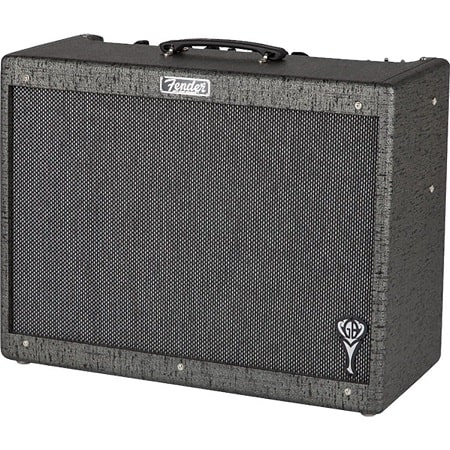 Fender George Benson Hot Rod Deluxe | Best Value 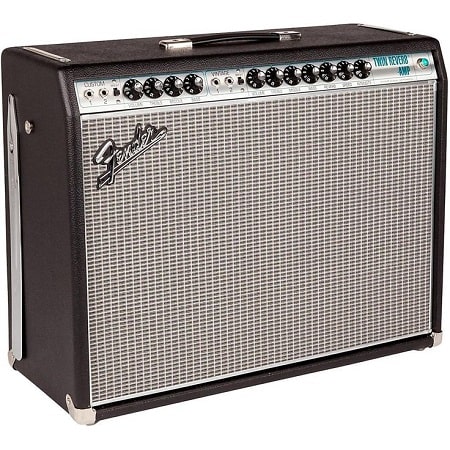 Fender ’68 Custom Twin Reverb | Premium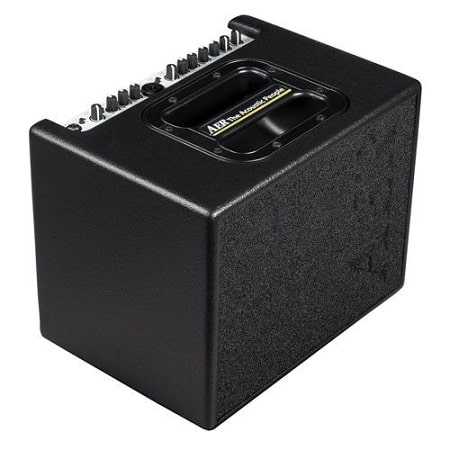 AER compact 60 | |
|---|---|---|---|
| Type: | Tube | Tube | Solid State |
| Number of Channels: | 3 | 2 | 2 |
| Total Power: | 40W | 85W | 60W |
| Speaker Size: | 1 x 12″ | 2 x 12″ | 1 x 8″ |
| Preamp Tubes: | 1 x 12AT7, 2 x 12AX7 | 4 x 12AX7, 2 x 12AT7 | No tubes |
| Power Tubes: | 2 x 6L6 | 4 x 6L6 | No tubes |
| EQ: | 3-band | 3-band | 3-band |
| Reverb: | Yes | Yes | Yes |
| Inputs: | 2 x 1/4″ | 2 x 1/4″ (custom), 2 x 1/4″ (vintage) | Inputs: Ch-1 6.3 mm (1/4”), Ch-2 combined XLR/6.3 mm (1/4”) |
| Footswitch I/O: | 1 x 1/4″ (channel, drive) | 1 x 1/4″ (reverb, vibrato) | 6.3 mm stereo jack |
| Footswitch Included: | Yes, a 2-button footswitch | Yes, a 2-button footswitch | No |
| Construction Material: | Solid Pine with Gray Tolex | Birch/Pine with Black Tolex | Black Tolex |
| Dimensions: | Height:18.75″ x Width: 23.5″ x Depth: 10.5″ | (Height: 19.87″ x Width: 26.15″ x Depth: 10.37″) | (Height: 16.75″ x Width: 14″ x Depth: 13″) |
10. Roland JC-22 Jazz Chorus
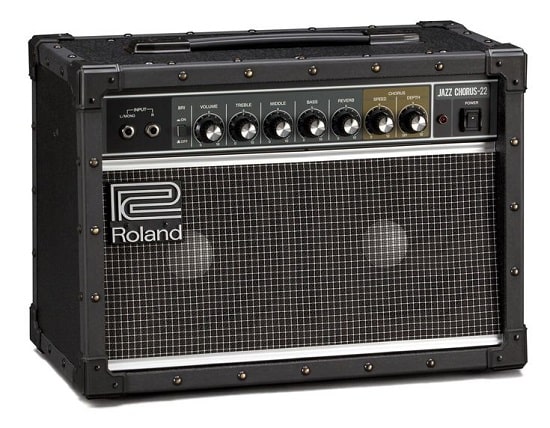
The JC-22 Jazz Chorus is a compact 30-watt amp that combines Roland’s original JC clean tone and iconic Dimensional Space Chorus effect.
This versatile stereo amp, which offers the fundamental features of the renowned JC-40 in a smaller size, is also ideal for small concerts and recording.
In addition to the onboard chorus, there’s a high-quality reverb and a stereo input on the front panel for connecting in modelers, multi-effects, and stereo stomps.
The JC-22 is built to the same sound and durability standards as the long-running amp line, making the iconic JC tone more affordable.
The JC Clean tone is a well-known sound used by jazz guitarists worldwide since to the brand’s dependability and the crisp, warm tone of their great clean sound.
It doesn’t have an overdrive option, which partially explains that the amp serves mainly to provide that rich, clean jazz sound.
| Specifications | |
|---|---|
| Type: | Solid State |
| Number of Channels: | 1 |
| Total Power: | 30W Stereo |
| Speaker Size: | 2 x 6.5″ speakers |
| EQ: | 3-band EQ |
| Reverb: | Yes |
| Inputs: | 2 x 1/4″ (left/mono, right) |
| Footswitch Included: | No |
| Footswitch I/O: | 2 x 1/4″ (chorus, reverb) |
| Dimensions: | (Height: 13.3″ x Width: 18.2″ x Depth: 9.4″) |
| Weight: | 26.5 lbs. |
9. ZT Lunchbox

The ZT Lunchbox Combo Amp is a lightweight, compact amp weighing not more than ten pounds.
It has 200 watts of power and can power an external cabinet while pumping a good volume through its 6.5″ internal speaker.
The Lunchbox can easily overpower the drum on its own.
It has the strength to handle any effects and the warmth and depth to sound fantastic with single-coil pickups and humbuckers, unlike every other amp of its size.
The Lunchbox amp’s clean tonal pallet is suitable for rock, blues, jazz, and country musicians.
It has all of the flexibility and responsiveness of a classic tube amp without the bulk, weight, or maintenance.
It’s become handy to musicians worldwide who admire its adaptability and portability.
One of these has been seen performing with a modern jazz guitar.
There are very few controls, but this gadget can produce a surprising volume for its size.
| Specifications | |
|---|---|
| Type: | Solid State |
| Number of Channels: | 1 |
| Total Power: | 35W |
| Speaker Size: | 1 x 6.5″ speakers |
| Controls: | Controls: Volume, Gain, Tone, Ambience, Line Out/Headphone Level |
| Inputs: | Aux Input 1/8″ Stereo Jack |
| Output: | Headphone/DI Output |
| Peak Output: | 120 dB at 1 meter |
| Dimensions: | (Height:6.5″ x Width: 7.8″ x Depth: 4.4″) |
| Weight: | 9.5 lbs |
8. Peavey Delta Blues 210
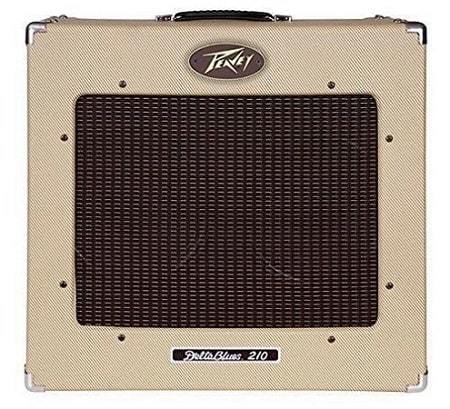
The Peavey Delta Blues 210 is a guitar amplifier produced by Peavey Electronics.
It’s a tube amp for blues performers, but it’s also a great jazz amp.
This amplifier has a traditional look, a classic sound, and modern versatility.
Assume you live a jazz and blues lifestyle. In that case, this is your amplifier.
Its classic all-tube 30-watt is far louder than solid-state.
A tremolo with speed and intensity settings, pre-and post-gain settings on the lead channel, 3-band passive EQ, a boosting switch, an external speaker input, and an effects loop add to the amp’s modern versatility.
As classic as it is, the amp features built-in tremolo effects and enables you to adjust the amount of gain and EQ.
This amp is the ideal jazz amplifier for someone not concerned about cost.
| Specifications | |
|---|---|
| Type: | Tube |
| Number of Channels: | 2 |
| Total Power: | 30W |
| Speaker Size: | 2 x 10″ |
| Power Tubes: | 4 x EL84 |
| EQ: | 3-band passive EQ (bass, middle, treble) |
| Footswitch Included: | Yes |
| Construction Material: | Classic tweed covering material, Chrome plated |
| Dimensions: | (Height: 25.62″ x Width: 24.37″ x Depth: 14.5″) |
| Weight: | 45.00 lbs |
7. Roland Cube Street
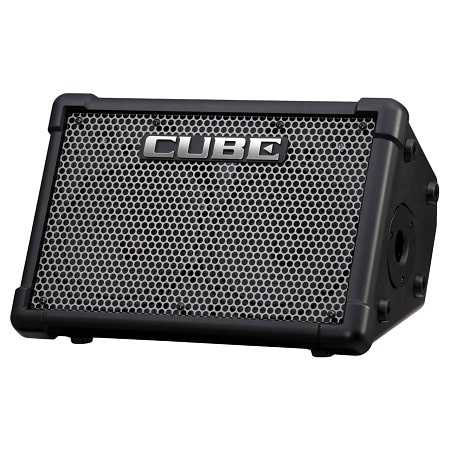
The Roland Cube Street is a great amplifier built specifically for busking artists.
It has two channels: one for microphones and one for guitars and instruments.
Roland’s CUBE Street was a significant favorite among traveling musicians with its tiny size and battery-powered operation.
The new CUBE Street EX injects a substantial performance boost into the popular mobile app, delivering a fantastic range, channels, and flexibility.
Fifty watts of output and a dual speaker with dual woofers and tweeters produce a crisp, punchy sound for larger gatherings.
At the same time, four independent channels provide many connections for various microphones and instruments.
Separate EQ and reverb settings allow for detailed sound tuning, and the inbuilt COSM amps make it simple to nail in superb guitar tones.
With 8 AA batteries, several power interfaces give up to 20 hours of performance, and two CUBE Street EX devices can be joined together for extra audio coverage if needed.
| Specifications | |
|---|---|
| Type: | Solid State |
| Number of Channels: | 4 |
| Total Power: | 50W |
| Speaker Size: | 2 x 8″ |
| Reverb: | Yes |
| EQ: | 3-band |
| Inputs: | 2 x XLR-1/4″ combo, 2 x 1/4″ (R, L/Mono), 2 x 1/4″ (Stereo), 1 x 1/8″ (aux), 1 x 1/4″ (aux) |
| Outputs: | 2 x 1/4″ (R, L/Mono) |
| Dimensions: | (Height: 12.1″ x Width: 19.3″ x Depth: 13.4″) |
| Weight: | 16.4 lbs. |
| Amp Modeling: | COSM Amp Modeling |
| Footswitch Included: | No |
| Footswitch I/O: | 2 x 1/4″ (chorus/delay, reverb) |
6. Fender Champion 100
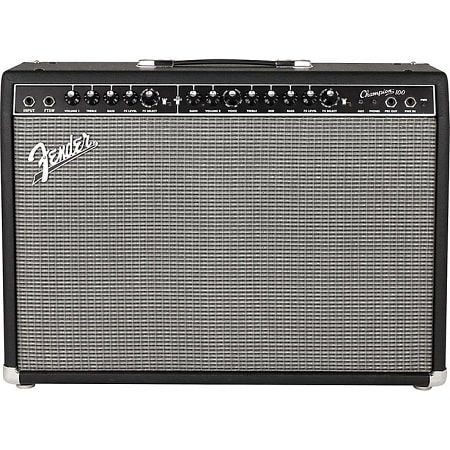
The Fender Champion amplifier is simple and fits with any form of guitar playing due to its flexibility.
The 100-watt Fender 100 should be a thoughtful choice for its powerful 2×12″ practice amp and budget-friendly performance amp.
The amp is easier to tune in with the perfect sounds for Jazz, blues, metal, rock, and country due to its simple controls, unique effects, and various amp voicings.
It isn’t designed primarily for jazz, but it does it pretty effectively.
This solid-state amp combines a robust inner design with a more contemporary ability to layer multiple effects on top.
This is useful in more current jazz styles.
This amp has a headphone output jack for comfortable personal listening.
Aside from its outstanding unshaded tone, many Fender amps include inbuilt effects that provide a diverse range of tone coloring, timbres, and textures.
Chorus, reverb, tremolo, delay, and other effects are included.
| Specifications | |
|---|---|
| Type: | Solid State |
| Number of Channels: | 2 |
| Total Power: | 100W |
| Speaker Size: | 2 x 12″ |
| Reverb: | Yes |
| EQ: | 3-band |
| Inputs: | 1 x 1/4″ (instrument), 1 x 1/4″ (power amp in), 1 x 1/8″ (aux) |
| Outputs: | 1 x 1/4″ (preamp out) |
| Dimensions: | (Height: 19″ x Width: 26″ x Depth: 10.25″) |
| Weight: | 40 lbs. |
| Headings: | 1 x 1/8″ |
| Footswitch Included: | Yes, a 2-button footswitch |
| Footswitch I/O: | 1 x 1/4″ (channel, effects) |
5. Vox AC30 C2
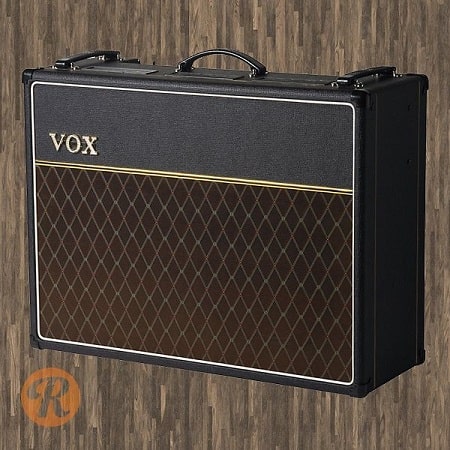
The AC30 is a less traditional jazz amplifier option, but it is still worth investigating.
Vox amps have a brighter, ‘janglier,’ and less noticeable low end than Fender amps.
Considering this, the AC30 improves on the enthralling sound of its smaller sibling by doubling the watts.
The AC30 Custom uses four EL84 power tubes to deliver 30 watts of distinct tone over a pair of 12-inch Celestion Greenback speakers.
This amp can produce both appealing clean and boisterous overdriven tones.
The AC30 Custom’s characteristic chime blends effortlessly with the complexities of your style of play, delivering a unique sound.
The AC30, VOX’s most iconic amplifier, was known as the amplification that fueled the British Invasion.
| Specifications | |
|---|---|
| Type: | Tube |
| Number of Channels: | 2 |
| Total Power: | 30W |
| Speaker Size: | 2 x 12″ |
| Reverb: | Yes |
| EQ: | 2-band |
| Inputs: | 4 x 1/4″ (high/low normal, high/low top boost) |
| Outputs: | 2 x 1/4″ (8/16 ohms) |
| Dimensions: | (Height: 21.89″ x Width: 27.64″ x Depth: 10.43″) |
| Weight: | 70.99 lbs. |
| Headings: | 1 x 1/8″ |
| Footswitch Included: | No |
| Footswitch I/O: | 1 x 1/4″ (channel, reverb) |
| Construction Material: | Black Tolex |
| Preamp Tubes: | 3 x 12AX7 |
| Power Tubes: | 4 x EL84 |
4. Roland AC-60 Acoustic Chorus Guitar Amplifier
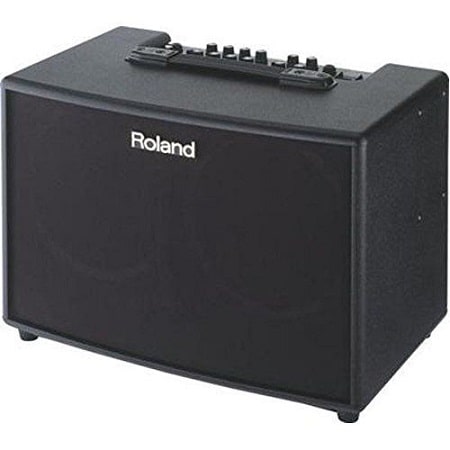
The Roland AC-60 Acoustic Chorus is a new edition of Roland’s well-known JC Jazz Chorus amp range.
The Roland AC-60 is ideal for acoustic guitars, but it would also work well with a hollow body archtop guitar to generate clear and sharp acoustically authentic tones for jazz.
This amp includes digital signal processing providing a clean tone with stereo/multi-band chorus and a wide mode with delay/reverb and excellent Auto Anti-Feedback control.
And, with its 2-channel Mic/Line architecture and stand-mountable format, the AC-60 stands out from the crowd
The AC-60 has a three-band equalization for bass, mid-range, and high frequencies on both channels and a chorus push-button controlled by a volume knob.
The Roland AC-60 Acoustic Chorus is ideal for a somewhat traditional jazz guitarist.
| Specifications | |
|---|---|
| Type: | Solid State |
| Number of Channels: | 2 |
| Total Power: | 60W |
| Reverb: | Yes |
| Inputs: | Inputs: XLR Jack Combo (Ch 1), 6.3 mm Jack (Ch 2), 2 x 6.3 mm Jack/RCA (Aux-In) |
| Outputs: | 2 x XLR (Line-Out L/R), 2 x 6.3 mm Jack (Ine-Out, Subwoofer-Out) |
| Dimensions: | (Height: 10.63″ x Width: 14.96″ x Depth: 10.55″) |
| Body Material: | Plastic |
| Footswitch Included: | Yes |
| Footswitch I/O: | 1 x 1/4″ (reverb, vibrato) |
3. AER compact 60

The AER compact 60 is a favorite of many jazz musicians, including Russell Malone.
This acoustic amp is very transparent, and when used on an archtop guitar, it can produce a rich, sweet, ‘wooden’ tone.
The AER compact 60 has proven to be a comprehensive, compact, robust, and straightforward complete package for performance, recording, and home use that meets acoustic performers’ highest needs and standards.
The tone aims to produce a sound that is more suited to an acoustic guitar than a jazz performance, but when playing acoustic jazz, this is precisely what you want, with superb dynamic response and a snappy warmth.
The AER Compact 60 is among the smaller and lightest acoustic amplifiers on the market.
It produces 60 Watts RMS of power with a single 8-inch front-facing speaker.
This combination delivers more than enough power for small or medium-sized gigs.
| Specifications | |
|---|---|
| Type: | Solid State |
| Number of Channels: | 2 |
| Total Power: | 60W |
| Reverb: | Yes |
| Inputs: | Ch-1 6.3 mm (1/4”), Ch-2 combined XLR/6.3 mm (1/4”) |
| FX: | Pan, select, level, aux level |
| Dimensions: | Dimensions: (Height: 16.75″ x Width: 14″ x Depth: 13″) |
| Weight: | 19.86 lbs |
| Footswitch Included: | No |
| Footswitch I/O: | 6.3 mm stereo jack |
| EQ: | 3 band |
| Speaker size: | 1 x 8″ |
2. Fender ’68 Custom Twin Reverb

The Fender ’68 is a unique high amp that jazz guitarists worldwide appreciate.
The manual settings on the ’68 Custom Twin Reverb provide considerable flexibility for both vintage and custom channels.
Traditionalists will love the amp’s rotary controls, which are sturdy and quick.
The custom channel includes volume, treble, midrange, bass controls, and a bright switch.
On the other hand, the vintage channel includes a reverberation control with independent speed and strength controls.
These amplifiers have four hand-wired 6L6 output tubes and six preamp tubes.
All the tubes are connected to vintage-spec Schumacher transformers and two 12″ Celestion G12V-70 speakers for 85 watts.
| Specifications | |
|---|---|
| Type: | Tube |
| Number of Channels: | 2 |
| Total Power: | 85W |
| Reverb: | Yes |
| Inputs: | 2 x 1/4″ (custom), 2 x 1/4″ (vintage) |
| Dimensions: | (Height: 19.87″ x Width: 26.15″ x Depth: 10.37″) |
| Footswitch Included: | Yes, a 2-button footswitch |
| Footswitch I/O: | 1 x 1/4″ (reverb, vibrato) |
| EQ: | 3 band |
| Speaker size: | 2 x 12″ |
| Preamp Tubes: | 4 x 12AX7, 2 x 12AT7 |
| Power Tubes: | 4 x 6L6 |
1. Fender George Benson Hot Rod Deluxe

Guitarists of various genres use Fender Hot Rod Deluxe amps.
They provide distinctive Fender tone, are ideal amps for customizing your sound, and are highly receptive to any preferred stompbox effects.
It is a 40-watt 1×12″ combo that has been meticulously adjusted for world-renowned jazz guitar maestro and pop star George Benson.
It boasts a versatile all-tube preamp with a 12AT7 up front for a cleaner tone, particularly with humbucking pickups and the complete bottom end typical of 6L6 tubes.
The intensity of Benson’s singing soloing technique is handled with clarity and range by a 100-watt Jensen C12K speaker, and the solid pine cabinet adds tonal resonance while lowering weight.
Clean and drive channels are standard, as is resounding Fender spring reverb and an effects loop.
It has a matching 1×12″ extender shell that increases output, richness, and stage coverage.
This amp sounds lovely, with a natural, warm tone that holds its clarity as the volume climbs, thanks to a great combination of tubes and a single 12″ Jensen C12K speaker.
| Specifications | |
|---|---|
| Type: | Tube |
| Number of Channels: | 3 |
| Total Power: | 40W |
| Reverb: | Yes |
| Inputs: | 2 x 1/4″ |
| Dimensions: | 18.75″ x Width: 23.5″ x Depth: 10.5″ |
| Footswitch Included: | Yes, 2-button footswitch |
| Footswitch I/O: | Footswitch I/O: 1 x 1/4″ (channel, drive) |
| EQ: | 3 band |
| Speaker size: | 1 x 12″ |
| Preamp Tubes: | 1 x 12AT7, 2 x 12AX7 |
| Power Tubes: | 2 x 6L6 |
Conclusion
When choosing an amplifier for jazz music playing, there’s one significant question to consider initially: should you use a solid-state amplifier or a tube amplifier?
Tube amplifiers, often known as ‘valve amps,’ increased the guitar sound using vacuum tubes and were also the earliest form of electric guitar amplifiers. They have exceptionally soft and are very responsive to playing dynamics.
The more sophisticated solid-state state amplifier uses transistors to amplify your signal. They are often smaller and lighter than tube amplifiers, but they may be shockingly loud for their size.
This article should have given you a better understanding of your choices regarding purchasing a quality jazz guitar amplifier.
The main thing to consider while looking for a proper amp is finding a decent combination of Clarity, Crispness, and Clen tone.
